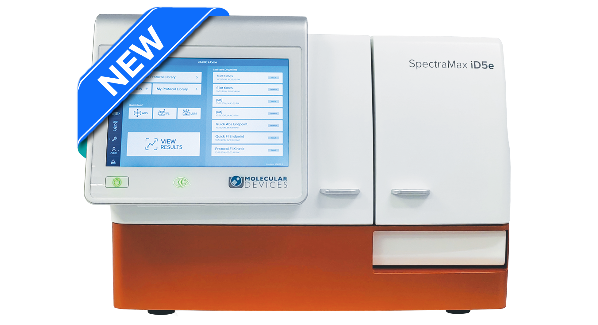Designed for today’s assays and tomorrow’s breakthroughs—flexible detection that evolves with your science.
The SpectraMax® iD3s and iD5e Multi-Mode Microplate Readers deliver flexible, scalable solutions for absorbance, fluorescence, and luminescence assays—with advanced capabilities for evolving research needs. The iD3s reader offers a streamlined, affordable platform with a tunable monochromator and temperature control, while the iD5e reader adds enhanced detection modes including time-resolved fluorescence (TRF) and tunable fluorescence polarization (FP) and can be expanded to include TR-FRET, HTRF, BRET and western blot. Both readers support on board fluidics with optional dual injectors.
For live-cell assays and microbial growth experiments, environmental control for CO₂/O₂ regulation and advanced shaking are available to maintain ideal growth conditions. Data acquisition and analysis are driven by SoftMax® Pro Software—the most cited microplate reader software in the industry.

Supports diverse assay needs
Perform ELISA, nucleic acid and protein quantitation, cell viability, microbial assays, western blot, and more.

Simplified setup & analysis
Over 200 preconfigured protocols and intuitive setup tools help streamline data acquisition and analysis—backed by the industry’s most cited microplate reader software.

Fast, consistent mixing for high-performance flash assays
Dual injectors available for fast kinetic assays with SmartInject® Technology, ensuring complete reagent mixing in every well for high-precision with 10 µL dead volume.
Features

Superior hybrid optical system
The high-efficiency monochromator and filter-based optical system, combined with an ultra-cooled photomultiplier tube (PMT), minimizes noise while increasing sensitivity, selectivity, and dynamic range.

Live cell assays
Advanced shaking and user-installable gas mixer (CO2/O2) that support ideal environments for cell-based and microbial growth experiments are available as optional upgrades.

Automatic filter identification
Automatically identify filter sets using NFC functionality, simplifying workflows and ensuring accuracy and reliability.

Flexible temperature control
Precise and intuitive temperature regulation—from 5°C above ambient conditions up to 66 °C—empowering your lab to perform a wide range of temperature-sensitive assays with confidence.

Read height optimization (Z height)
Z-height optimization automatically adjusts the detection height to maximize sensitivity and signal quality—while minimizing sample volume—ensuring reliable results even in low-volume or precious samples.

Microvolume & cuvette options
The SpectraDrop Micro-Volume Microplate for low-volume (2 to 4 μL) and SpectraCuvette™ Adapter Plate for cuvette-based applications eliminate the need for additional instrumentation.

Personalized touchscreen control
The intuitive touchscreen software simplifies tasks with Quick Read icons that save time when starting new experiments and a personalized library that stores frequently used protocols.

Western blot capable
The optional enhanced time-resolved fluorescence (TRF) detection module is optimal for quantitating as little as femtogram protein samples, providing improved sensitivity, extended signal stability and versatility to support a wide range of applications.
Next-Level Performance for Everyday Research
SpectraMax® iD3s reader: Streamlined power for everyday assays
- 3 detection modes: absorbance, fluorescence, and luminescence
- CO₂/O₂ control and shaking options for live-cell support
- Dual injectors for fast, high-precision reagent mixing
- Tunable monochromator with 1-nm wavelength increments for full wavelength flexibility


SpectraMax iD5e reader: Advanced detection for complex assays
- 5 detection modes including TRF and fluorescence polarization
- Dual injectors for fast, high-precision reagent mixing*
- CO₂/O₂ control and advanced shaking options for live-cell support*
- TR-FRET, HTRF®, and bottom-read luminescence*
- Hybrid optics for monochromator flexibility + filter-based sensitivity
- Western blot detection with femtogram sensitivity*
* Optional features
Latest Resources
Featured Applications
Customer Breakthrough
Applications of SpectraMax iD3s and iD5e Multi-Mode Microplate Readers
Specifications & Options of SpectraMax iD3s and iD5e Multi-Mode Microplate Readers
*Using lowest settings and speed read when available.
Download Brochure



